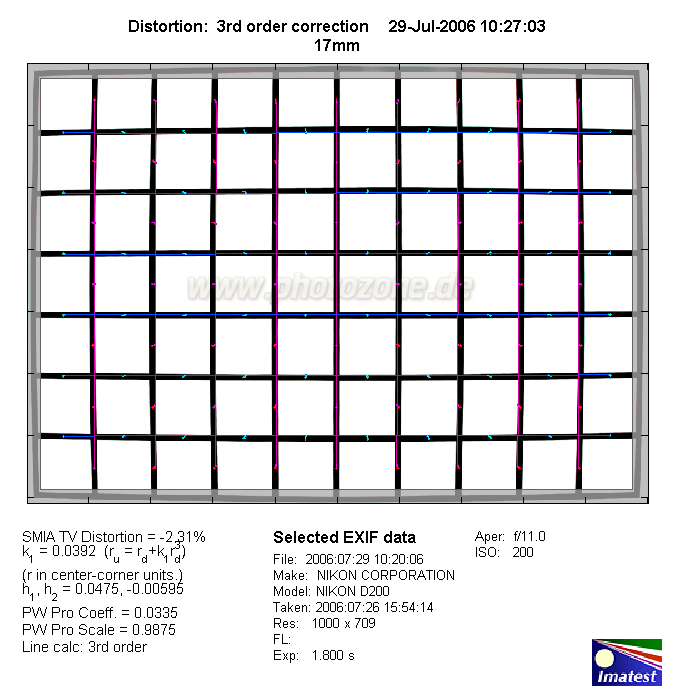|
Nikkor AF-S 17-35mm f/2.8 D IF-ED - Review / Lab Test Report - Analysis |
|
Lens Reviews -
Nikon / Nikkor (APS-C)
|
|
Page 2 of 2
Distortion
The AF-S 17-35 mm shows a quite typical distortion characteristic for a lens in
this class. At 17 mm there is pronounced barrel distortion (2.3%) which eases
towards the long end of the zoom range. At 35mm the lens is basically free of
distortion.
|
Move the mouse cursor over the focal length text marks below to observe the respective distortions
|
| 17mm |
24mm |
35mm |
|

|
The chart above has a real-world size of about 120x80cm.
Vignetting
Thanks to the full frame design the Nikkor AF-S 17-35mm ED shows little
vignetting on the D200. At 17mm it doesn't even matter whether you use the
lens wide-open or stopped-down. Interestingly the vignetting increases towards
the long end of the zoom range - probably a side effect of the camera sensor
characteristic. At 35mm @ f/2.8 is even quite pronounced at around 0.8EV so
in critical situations you may prefer to stop down a little at this setting.

MTF (resolution)
The AF-S 17-35mm f/2.8 ED produced very good to excellent resolution figures
in the MTF lab. The center resolution is excellent throughout the tested
aperture range and at all focal length - it scratches and may possibly
even exceed the sensor resolution of the D200 at f/4 here (at 17mmm and 24mm).
The borders suffer from a performance penalty at large aperture settings
at 17mm (still good) and to a lesser degree at 24mm (already very good).
Nonetheless the quality increase when stopping down peaking in an excellent
performance around f/5.6.
There's a slight decrease in quality at 35mm primarily at the borders which
are no longer capable to leave very good territory here.
The lens suffers somewhat from field curvature specifically at 17mm only.
Please note that the MTF results are not directly comparable across the different systems!
Below is a simplified summary of the formal findings. The chart shows line widths per picture height (LW/PH) which can be taken as a measure for sharpness.
If you want to know more about the MTF50 figures you may check out the corresponding Imatest Explanations
Chromatic Aberrations (CAs)
Chromatic aberrations (color shadows at harsh contrast transitions) are very well
controlled for such a zoom lens. The issue remains below 1px on the average at the image borders.

Verdict
The Nikkor AF-S 17-35mm f/2.8D IF-ED is a professional grade lens and it delivers
accordingly specifically regarding its superb build quality. The optical quality
is on a very high though not unprecedented level. The center resolution is superb
followed by generally very good borders. Distortions are quite pronounced at 17mm but
not a real problem beyond. Vignetting is very well controlled except at 35mm @ f/2.8.
CAs are very low for a zoom lens. All-in-all the performance is very similar to the
AF-S 17-55m f/2.8G IF-ED DX in the overlapping range so for (APS-C) DSLR-only users
it may make sense to stick to the dedicated lens. For a dual-use strategy (film + digital
and possibly full frame DSLRs in the future) the AF-S 17-35mm f/2.8D IF-ED remains a
quite obvious choice.
|